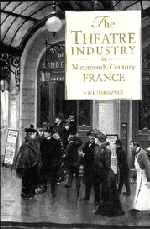Book contents
- Frontmatter
- Contents
- Chronology
- Introduction
- PART I THE AUDIENCES
- 1 Going to the theatre in the nineteenth century
- 2 The auditorium
- 3 Performance times – intervals – annual closures
- 4 First nights and previews
- 5 Order and disorder in the theatres
- 6 Applause and censure
- 7 The claque
- 8 Working-class audiences
- PART II THE ACTING PROFESSION
- PART III THE PROFESSION OF PLAYWRIGHT
- Notes
- Bibliography
- Guide to further reading
- Index
6 - Applause and censure
Published online by Cambridge University Press: 07 December 2009
- Frontmatter
- Contents
- Chronology
- Introduction
- PART I THE AUDIENCES
- 1 Going to the theatre in the nineteenth century
- 2 The auditorium
- 3 Performance times – intervals – annual closures
- 4 First nights and previews
- 5 Order and disorder in the theatres
- 6 Applause and censure
- 7 The claque
- 8 Working-class audiences
- PART II THE ACTING PROFESSION
- PART III THE PROFESSION OF PLAYWRIGHT
- Notes
- Bibliography
- Guide to further reading
- Index
Summary
The tribute of applause awarded to the actors at the end of a play, which today arrives almost automatically to round off a performance, was formerly much more frequently and generously accorded, particularly at theatres which habitually attracted a large proportion of working-class spectators; whether they were more uncritical or more apt to give rein to their enthusiasm than their ‘betters’, it is hard to say. Writing of the Ambigu-Comique in 1837, Gautier stated that ‘every successful performance gives rise in this theatre to unparalleled ovations. All the actors are summoned to take a bow, along with the authors of the play, the scene-shifters, the prompter, and the theatre employees: bouquets are rained on the stage, everyone is crowned, even the box-openers come within an ace of participating in the general triumph.’ A generation earlier, under the Consulate, audiences even at the Opera had been used to manifest their pleasure in much the same uninhibited way. Of one of the idols of the day, Mademoiselle Maillard, an observer from Germany noted that ‘not a shriek, not a spasm of hers passes without a storm of clapping and cheering. The more she screams and fights the air, the wilder the bravos and the louder the clapping and stamping of feet.’
Clapping and stamping one's feet, or thumping one's walking stick on the wooden floor, were the traditional ways of manifesting approval of a performance; the shout bravo! came into French about the middle of the eighteenth century in imitation of Italian usage. But other, more unusual ways of applauding were also occasionally practised.
- Type
- Chapter
- Information
- The Theatre Industry in Nineteenth-Century France , pp. 91 - 100Publisher: Cambridge University PressPrint publication year: 1993



